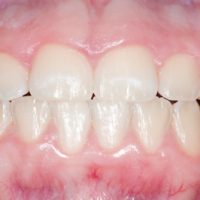A gummy smile, gingival hyperplasia, is very common following orthodontic treatment. While this condition usually resolves with time it happens very slowly. Cosmetically it is more desirable to show more tooth and less gum, so a simple procedure called a gingivectomy is employed. The gingivectomy is performed to remove the redundant gum tissues around the tooth to expose more of the natural tooth. There are many techniques for removing the gingiva – scalpel, electro surgery or a dental laser.
This case uses a CO2 laser to remove the tissue. This procedure can be performed quite comfortably with routine local anesthetics, though some patients will still opt for adjunctive IV conscious sedation. Following anesthesia, the base of the tooth is approximated. The laser is used to expose the natural tooth. There are proportions of the anterior teeth that must be respected for a natural looking outcome. The maxillary frenum was dissected at the time of this procedure as a preventive measure. Healing takes place in days following this procedure. The patient is usually given a chlorhexidine mouthwash and ibuprofen. They are instructed to brush normally following this procedure.
There are many nuances involved with treating a gummy smile. Other factors to consider are lip posture and bone levels around the teeth. This case was simplified as it did not require bone removal and the patients lip posture was normal.



After my dentist told me I needed laser gum surgery, I went into a total panic, have always had some 5 and 6 mm depth pockets in my mouth that have been of concern, but one of them finally flared up to a 9mm pocket. My dentist gave me a referral to a periodontist, and I was about 2 days away from my appointment
Periodontal disease is typically detected at your general dentists office. Depending on the complexity of the disease and your general dentist’s level of comfort in treating periodontal disease a referral to a Periodontist will be made. A Periodontist is a dentist who completes a 3 year post doctoral residency in the field of Periodontics. They receive intensive clinical and didactic training during this residency. It would be unusual for a dentist to make a referral specifically for laser gum surgery to treat periodontal disease vs just making a referral to treat the periodontal disease. Most Periodontists, who are unequivocally the best trained dental specialists for treating periodontal disease do not use a laser. A laser is a very fancy way to make a gingival incision or removing gingival tissue, but a scalpel works too. In fact, in some cases better than a laser, since a laser can only incise linearly. I have tried many types of YAG lasers in my practice all of which performed very poorly with incisions related to periodontal surgery. I do use a CO2 laser in my practice. The CO2 laser is the ideal laser for periodontal surgery as it will incise the outer layer of gingival tissue as well as the inner layer of connective tissue very efficiently. A YAG works well on the outer layer but very poorly on the inner connective tissue layer. The CO2 laser makes my life easier for some of the procedures that I perform but it doesn’t contribute to the success of the procedure. Here is the bottom line – if you have periodontal disease and your dentist has made a periodontal referral, by all means you should see a Periodontist for an exam and diagnosis. Following that exam your Periodontist will review your treatment options with you.